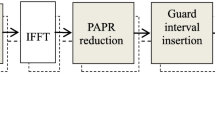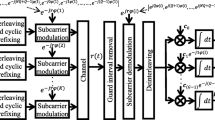Abstract
In this paper an adaptive optimized fast blind channel estimation using cyclic prefix supported with Space Time Block Coded Multiple Input Multiple Output Orthogonal Frequency Division Multiplexing (STBC-MIMO-OFDM) system is presented. The main aspire of our technique is to support multiple users at the same time over same frequency band based on the Multi-Carrier Code-Division Multiple Access (MC-CDMA) approach. High complexity and low convergence is the main obstacle in earlier blind channel estimation techniques. Modified flower pollination algorithm is implemented to overcome this problem. The MC-CDMA approach is utilized to implement the blind channel estimation. The proposed MC-CDMA is used to reduce the error rate included in the Blind Channel Estimation. As a part of wireless communications, time block coding technique is utilized to transmit several copies of information across the number of antennas. To develop the consistency of data transfer different received data is used and then MFPA results in lower fuel cost compared to FPA. MFPA produces better results compared with previous methods.








Similar content being viewed by others
References
Armstrong, J. (2009). OFDM for optical communications. Journal of light wave technology, 27(3), 189–204.
Hwang, T., Yang, C., Wu, G., Li, S., & Li, G. Y. (2009). OFDM and its wireless applications: A survey. IEEE Transactions on Vehicular Technology, 58(4), 1673–1694.
Wang, X., Ho, P., & Yiyan, W. (2005). Robust channel estimation and ISI cancellation for OFDM systems with suppressed features. IEEE Journal on Selected Areas in Communications, 23(5), 963–972.
Hassib, M. D., Singh, M., Ismail, M., & Nordin, R. (2012). Efficient and low complexity STBC-OFDM scheme over fading channel. In 2012 18th Asia-Pacific Conference on Communications (APCC) (pp. 402–406). IEEE.
Ku, M.-L., & Huang, C.-C. (2008). A refined channel estimation method for STBC/OFDM systems in high-mobility wireless channels. IEEE Transactions on Wireless Communications, 7(11), 4312–4320.
Chen, H.-Y., Meng-Lin, K., Shyh-Jye, J., & Huang, C.-C. (2010). A robust channel estimator for high-mobility STBC-OFDM systems. IEEE Transactions on Circuits and Systems I: Regular Papers, 57(4), 925–936.
Jeon, S., Han, J.-S., Choi, J.-M., & Seo, J.-S. (2015). Cooperative space-time block coded full-duplex relaying over frequency-selective channel. IET Communications, 9(7), 960–968.
Wang, D., Minn, H., & Al-Dhahir, N. (2008). A robust asynchronous multiuser STBC-OFDM transmission scheme for frequency-selective channels. IEEE Transactions on Wireless Communications, 7(10), 3725–3731.
Naeiny, M. F., & Marvasti, F. (2011). Selected mapping algorithm for PAPR reduction of space-frequency coded OFDM systems without side information. IEEE Transactions on Vehicular Technology, 60(3), 1211–1216.
Kwon, U.-K., Kim, D., Kim, K., & Im, G.-H. (2007). Amplitude clipping and iterative reconstruction of STBC/SFBC-OFDM signals. IEEE Signal Processing Letters, 14(11), 808–811.
Kwon, U.-K., Im, G.-H., & Kim, E.-S. (2007). An iteration technique for recovering insufficient cyclic prefix and clipped OFDM signals. IEEE Signal Processing Letters, 14(5), 317–320.
Alexander, P., Haley, D., & Grant, A. (2011). Cooperative intelligent transport systems: 5.9-GHz field trials. Proceedings of the IEEE, 99(7), 1213–1235.
Shin, C., Heath, R. W., & Powers, E. J. (2008). Non-redundant precoding-based blind and semi-blind channel estimation for MIMO block transmission with a cyclic prefix. IEEE Transactions on Signal Processing, 56(6), 2509–2523.
Ahn, S.-K., & Yang, K. (2013). A novel subblock-based frequency-domain equalizer over doubly-selective channels. IEEE Communications Letters, 17(8), 1517–1520.
Won, H.-C., & Im, G.-H. (2005). Iterative cyclic prefix reconstruction and channel estimation for a STBC OFDM system. IEEE Communications Letters, 9(4), 307–309.
Guo, Q., Ping, L., & Huang, D. (2009). A low-complexity iterative channel estimation and detection technique for doubly selective channels. IEEE Transactions on Wireless Communications, 8(8), 4340–4349.
Chen, S., & Zhu, C. (2004). ICI and ISI analysis and mitigation for OFDM systems with insufficient cyclic prefix in time-varying channels. IEEE Transactions on Consumer Electronics, 50(1), 78–83.
Sahin, A., & Arslan, H. (2011). Edge windowing for OFDM based systems. IEEE Communications Letters, 15(11), 1208–1211.
Liu, H., & Schniter, P. (2008). Iterative frequency-domain channel estimation and equalization for single-carrier transmissions without cyclic-prefix. IEEE Transactions on Wireless Communications, 7(10), 3686–3691.
MahmudulHasan, M. (2014). A new PAPR reduction technique in OFDM systems using linear predictive coding. Wireless Personal Communications, 75(1), 707–721.
del Amo, C. P., & García, M. J. F.-G. (2013). Iterative joint estimation procedure for channel and frequency offset in multi-antenna OFDM systems with an insufficient cyclic prefix. IEEE Transactions on Vehicular Technology, 62(8), 3653–3662.
Ma, C.-Y., Liu, S.-W., & Huang, C.-C. (2014). Low-complexity ICI suppression methods utilizing cyclic prefix for OFDM systems in high-mobility fading channels. IEEE Transactions on Vehicular Technology, 63(2), 718–730.
Singh, A., & Singh, H. (2016). Peak to average power ratio reduction in OFDM system using hybrid technique. Optik-International Journal for Light and Electron Optics, 127(6), 3368–3371.
Duanmu, C., & Chen, H. (2014). Reduction of the PAPR in OFDM systems by intelligently applying both PTS and SLM algorithms. Wireless Personal Communications, 74(2), 849–863.
Sarmadi, N., Shahbazpanahi, S., & Gershman, A. B. (2009). Blind channel estimation in orthogonally coded MIMO-OFDM systems: A semidefinite relaxation approach. IEEE Transactions on Signal Processing, 57(6), 2354–2364.
Author information
Authors and Affiliations
Corresponding author
Additional information
Publisher's Note
Springer Nature remains neutral with regard to jurisdictional claims in published maps and institutional affiliations.
Rights and permissions
About this article
Cite this article
Nandi, S., Pathak, N.N. & Nandi, A. A Novel Adaptive Optimized Fast Blind Channel Estimation for Cyclic Prefix Assisted Space–Time Block Coded MIMO-OFDM Systems. Wireless Pers Commun 115, 1317–1333 (2020). https://doi.org/10.1007/s11277-020-07629-z
Published:
Issue Date:
DOI: https://doi.org/10.1007/s11277-020-07629-z




